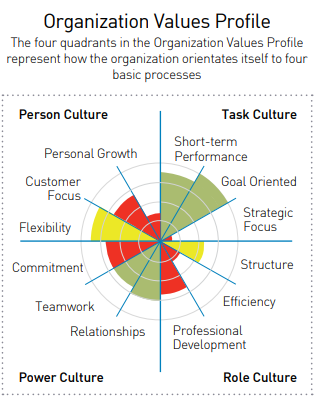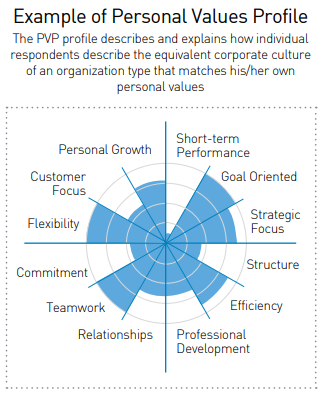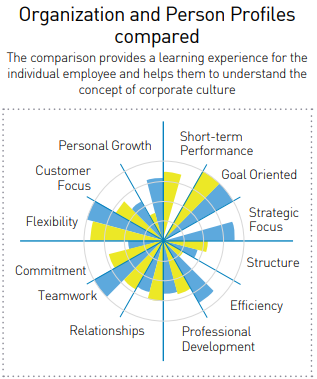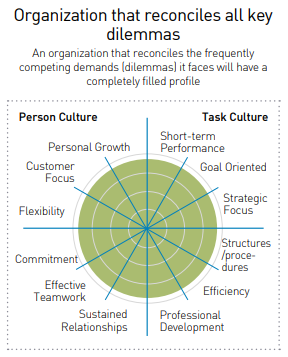A proposed new logic for employee engagement

Developed from our fundamental research and consulting practice, our new approach to employee engagement investigates dilemmas that derive from the tensions caused by the value differences between employing organizations and employees. For example, on the one hand, should we be directing/hands-on with staff, or on the other hand, empowering staff to be self-controlling and innovative?
The success of a company depends, among other things, on both the autonomy of its people and on how well the information arising from this autonomy has been centralized and co-ordinated.
If you fail to exploit fully centralized information, your scattered but highly self-motivated personnel might as well remain totally independent. If teams are not free to act on local information, then centralized directives are subtracting, not creating, value.
We first assess the value systems of the employing organization by asking employees to describe ‘how things are done around their organization’ using our online web tool, the Organization Values Profiler (OVP). OVP is an organizational culture scan based on the degree of formalization and flexibility, and on the degree of hierarchy and openness to the environment. It still has the underlying four-quadrant model of corporate culture but further sub-divides each quadrant leading to a full 12 segment model.
The four quadrants represent how the organization orientates itself to four basic processes in terms of task/strategy/mission, role/efficiency/consistency, power/human relations/involvement and person/learning/adaptability. Within each of the sub-segments, we explore specific competing demands that together determine the major orientations.

If one value dominates its opposite, organizations will find it increasingly difficult to recruit and retain talent as they are not addressing the value(s) that is (are) subjugated. For example, Does the organization encourage people to meet deadlines for short-term results or give priority for a visionary long-term future? Do people take individual responsibility or rather share in teams?
Sectors in red are where employees describe their workplace as often giving too much emphasis on Value Y rather than its opposite Value X. (or emphasizing X rather than Y).
Sectors shown in yellow are where employees describe common practice where people tend to choose a compromise by alluding only to some aspects of both values.
Sectors shown in green are where employees describe people managing the tensions between these (opposite) competing values.
Of particular importance is that the diagnostic is designed in such a way that it reflects our underlying philosophy that bipolar scales (i.e. more of one meaningless than the other alternative) are fundamentally inappropriate for the type of assessment we are seeking. We undertook extensive formal research and field testing to finalize the questions including Cronbach Alpha reliability analysis and triangulation with face-to-face and online semi-structured interviews. Respondents can score any sub-component high or low that collectively combine to form the constructs being assessed. In this way, one can score high on all 4 quadrants and all its 12 segments. No longer is an organization of only one stereotype. This reflects our conceptual framework where an integrated organization harnesses the strengths of all extremes and is not restricted to choosing between extreme options.
By using cross-validating questions, we have verified whether opposites and contradictions within one corporate culture have been reconciled. So, for example, we ask respondents to rate statements such as “There is a clear and overt strategy for the future” (Guided Missile) and “Through our short-term thinking, we are quick on our feet” (Incubator). They are validated by a (combination) reconciling questions such as “We are able to meet short-term demands without compromising our long-term vision.” (Reconciliation).
In earlier versions of these types of models, we would have to show a scale between short- and long-term orientations. In this new reconciling framework, we can score high or low on both! And a high score on both indicates a more powerful and higher performance culture. Another example is the tension between task (Guided Missile) and People (Family) Orientation which we explore with the contrasting questions: “There is a lot of teamwork” and “People strive for self-realization” and the validating question “We have teams that consist of creative individuals”.

Then secondly, we invite employees to complete our Personal Values Profiler (PVP). They select a set of personal values that best describes their own personal preferences for a work environment. There are no right or wrong answers (it is not an assessment) and individual employees will have each their own preferences. The aim is to explore the degree of overlap between the spread of preferences of employees and the corporate culture of their employer. To help respondents, they are guided through a series of steps containing a number of personal values. At each step, they review the personal values and by iteration remove those values that apply less to them personally until they finish with a final list of the most relevant to them individually. In addition, they indicate further prioritization by the ranking of their selected values.The end result is a series personal of values that are representative of the workplace culture each respondent would prefer.
Links between organizational culture and these values had been researched rigorously by one of our doctoral students Nicci Broom at Anglia Ruskin College, Cambridge with exhaustive linguistic analysis cross-correlated with transcripts of interviews and the host organizations’ documents and company literature. Her thesis “I work, therefore I am” led to a conceptual framework that quantifies organization culture, based on personal values. This was also developed by another of our researchers Sian Watt (La Trobe University, Victoria, Australia) in her doctoral thesis “Probing linkages between models of innovation and corporate culture”. These frameworks were further validated by Lucy Hogg, Anglia Ruskin College, Cambridge in her doctoral thesis “Understanding a firm’s values: an ethnographic perspective.”

Based on the above methodology, we can compute an equivalent profile from the personal values ranked by respondents. The PVP profile describes and explains how individual respondents describe the equivalent corporate culture of an organization type that matches his/her own personal values and again illustrates the different priorities given to people, power, tasks and work roles in their ideal employer work environment.
Interpreting responses (individual respondents)

If his/her profiles are similar: When using our interactive App-based version, individual respondents receive immediate feedback of their description of their organization compared to their own personal preferences and these tensions are shown as dilemmas. The exercise as a whole provides a learning experience for the individual employee and helps them to understand the concept of corporate culture.
On the one hand, this should indicate a close match between how the organization operates and the type of work environment he/she prefers. But other people in their organization he/she works with might have different views and he/she may find tensions between the way he/she works and they work.
If his/her profiles differ in many respects:
This should not automatically mean frustration in his/her work and lead to demotivation. Such differences can be a source of stimulation and learning. In the same way, that diversity means many different points of view, by harnessing different points of view can lead to even higher satisfaction and morale.
Interpreting responses – Mining the data from all employees
Analysis of variance of all responses across age ranges, length of tenure, and the functional discipline of respondents provides a basis for the organization to develop a new approach to employee engagement over and above classic employee surveys.
We need a new way of thinking to best explore the wisdom hidden in such data because we are not talking simply about a process akin to matching the values systems of potential job candidates with a detailed job description, which in itself is another coded form of the value systems of the organization. This has the danger of just being a sophisticated form of cloning. Employee engagement needs to be a marriage, not a showy expensive wedding.
To understand the rationale behind our new approach, let’s go back to 10th-grade physiology classes where we learned about the basic human Blood Group divisions as a metaphor. People with type AB Rh D positive blood are often called universal recipients as they can receive blood from any donor. Individuals with type O Rh D negative blood are often called universal donors as their blood can be given to anyone.
Now, an organization that reconciles the frequently competing demands (dilemmas) it faces will have a completely filled profile.
This is our blood type metaphor is a type AB universal recipient. It can employ any employee irrespective of his/her own personal values because all pathologies are accommodated and is therefore attractive to all potential employees. The employee may be highly individualized, but the employing organization reconciles individual and team working. If the employee is very much team oriented, then he/she will also be engaged for the same reason.
In passing, we can also note that an individual employee who himself/herself has a fully reconciled personal profile we can equate to the type O and brand as a universal employee. Such employees can themselves accommodate different types of a working environment through their own capacity to be flexible and reconcile the dilemmas of engagement. They can accommodate working in teams and as a high performing individual, whatever their work environment demands.

The new approach to employee engagement to win the war for talent
Organizations need to become “Type AB Universal Employers” by eliciting their key dilemmas and embedding the corresponding reconciliations.
All organizations need stability and change, tradition and innovation, public and private interest, planning and laissez-faire, order and freedom, growth and decay. The consequence is that the systems and processes of resourcing talented employees must change to develop a new mindset of inquiry and support centered on the reconciliation of such key dilemmas.
Like our blood group analogy where there are at the next level of detail, many more blood sub-group types, in practice any employing organization will unlikely have a perfectly circular organization profile (and will not be “pure AB type”) as they will retain some focus or orientation that reflects their corporate identity and differentiates them from their competitors and retains some characteristics of their founding history. Similarly, potential employees will never all be truly Type O universal employees. The few that might adhere to this type would be rare and likely to be the next generation of employing entrepreneurs!
In practice, real managers and real employees must decide and execute interactively. In this new world of the customized workplace in which priority for sustained personal development goes hand-in-hand with the employer’s business performance and growth, the reconciliation of dilemmas is the new source of authority and engagement through collaboration will succeed.











